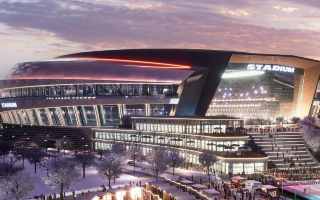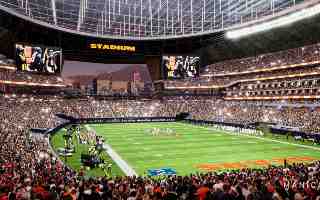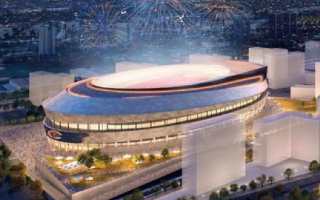New Chicago Bears Stadium
| Capacity | 65 000 |
|---|---|
| Country | United States of America |
| City | Chicago |
| Clubs | Chicago Bears |
| Category | Design outdated |
| Cost | $3.225 B |
| Construction | 2025–2028 |
| Design | Manica Architecture |
Advertisement
New Chicago Bears Stadium – design description
How can the new Chicago Bears stadium project next to Soldier Field be summarized?
The futuristic design for the new Chicago Bears stadium envisioned a fully roofed structure covering both stands and the field, with a capacity exceeding 65,000 spectators. Its most distinctive feature was to be a massive “window” opening toward the skyline of downtown Chicago.
The venue was planned to rise right next to the existing Soldier Field, with the concept prepared by Manica Architecture and unveiled on April 24, 2024.
Just over a year later, however, the direction shifted – in September 2025 it was announced that the stadium would not be built in the heart of Chicago, but in the suburb of Arlington Heights, where the Bears had already acquired land for a potential investment.
New renderings have also been presented, showing the venue looking identical to the stadium planned near Soldier Field. The 2024 concept may therefore still come to life, though in a different location.
Where did the idea of building a new stadium for the Chicago Bears come from?
In the 21st century, a trend emerged of constructing extremely expensive, ultra-modern stadiums for NFL teams. Leading examples of this tendency include SoFi Stadium and Allegiant Stadium, both opened in 2020. A nearly inseparable feature of these next-generation venues is a roof covering not only the stands but also the playing field (either fixed, or retractable).
One of the NFL teams with high ambitions in terms of infrastructure is the Chicago Bears. Since 1971, the Bears have played at Soldier Field, located near downtown Chicago on the Lake Michigan waterfront. The stadium was originally opened in 1924 and underwent a complete reconstruction in 2002–2003, which at the time made it one of the most modern venues in the league.
Over time, however, Soldier Field began to fall behind other stadiums. It lacks a roof, and with a capacity of 61,500 it is the smallest stadium in the NFL. It should also be noted that Chicago, the third-largest metropolitan area in the United States, has never hosted a Super Bowl. To change that, either a major modernization of Soldier Field or the construction of a brand-new stadium would be necessary.
With this in mind, the Bears began considering a new stadium even before Soldier Field was fully paid off and long before the end of the team’s lease (set to expire in 2033).
What concepts were considered in relation to the plans for a new Chicago Bears stadium?
Where did the Bears initially plan to build the new stadium?
In 2021, the Bears expressed interest in purchasing the Arlington Park racecourse in Arlington Heights (a far suburb of Chicago, about 25 mi / 40 km from downtown), as the site for a new stadium. An agreement was signed on September 21, 2021 (the purchase was finalized in early 2023, with the Bears paying $197.2 million).
Could renovating Soldier Field have been an alternative to building a new stadium?
In response to the Bears’ plans to relocate to a distant suburb, then-mayor of Chicago, Lori Lightfoot, presented renovation proposals for Soldier Field on July 25, 2022, intended to persuade the team to remain at their current location. Three options were unveiled. The most spectacular (and also the most expensive – estimated at $2.2 billion) called for covering the stadium with a massive glass roof supported by four columns.
The Chicago Bears, however, remained committed to their relocation plans in Arlington Heights. On September 6, 2022, shortly after the Soldier Field renovation concepts were revealed, a preliminary development plan was presented for the Arlington Park site, with a new stadium as its centerpiece (alongside a large mixed-use residential and entertainment complex).
In January 2023, Kevin Warren was appointed president and CEO of the Chicago Bears. Warren was known for the key role he played in the construction of U.S. Bank Stadium during his time with the Minnesota Vikings. His top priority in Chicago was to secure a new stadium for the Bears.
When did the Bears begin considering alternative locations for a new stadium?
By mid-2023, the Bears began signaling that building in Arlington Heights was not a foregone conclusion. The team was dissatisfied with the property tax burden, and negotiations on this issue were not yielding satisfactory results. Meanwhile, mayors from other suburbs reached out to the team, offering support to host a new stadium in their communities.
The Bears began exploring different possibilities. By late 2023, reports surfaced that one of the options under consideration was land adjacent to Soldier Field, where a new stadium could be built. From early 2024 onward, further reports continued to confirm this location as the team’s preferred choice.
When was the concept of a new stadium next to Soldier Field unveiled?
On April 24, 2024, the day before the NFL Draft, a press conference was held at Soldier Field to officially present the concept for a new Chicago Bears stadium. The design was created by Manica Architecture, one of the leading firms specializing in sports venues.
Where was the new Bears stadium supposed to be built?
As earlier leaks had suggested, the stadium was planned for a site directly south of Soldier Field, on the area occupied by the Waldron Deck parking structure. Although the project called for the demolition of the old stadium, its century-long tradition was meant to be preserved, with the Bears remaining virtually in the same location where they had been playing for more than 50 years.
What did the design of the new Chicago Bears stadium next to Soldier Field include?
The venue was envisioned with an oval, dynamic form, featuring glass elements, metal panels, ceramics, and wood in its façade. Its most distinctive feature was to be a vast opening in the northern end zone façade – the “window” – positioned to provide interior views of Chicago’s skyline with its many skyscrapers.
One of the project’s greatest strengths was a permanent roof covering both the stands and the playing field. A large central portion of the roof was to be made of transparent ETFE material. A similar roof structure can be found at Allegiant Stadium, while another comparable example is planned for the new Tennessee Titans stadium.
The concept also featured a striking roof detail: its central transparent section was surrounded by a massive letter “C,” clearly visible from above and directly referencing the Bears’ iconic logo. The exterior wall was further enhanced with a panoramic terrace offering views of the city and Lake Michigan.
The design aimed to reflect modernity and the spirit of Chicago, while also incorporating elements that harmonized with the neoclassical architecture of the neighboring Museum Campus buildings.
Inside, the stands were to be divided into multiple tiers, with a planned capacity of over 65,000 spectators. The layout was distinctly football-oriented, yet adaptable to accommodate a soccer pitch as well. The interior was to feature large video boards, along with a wide range of premium amenities for fans.
What role was the new Chicago Bears stadium intended to serve?
The facility was primarily designed for the NFL team, the Chicago Bears, but given the relatively limited number of home games in a season, it was also meant to host numerous other sporting and cultural events.
Thanks to its modern infrastructure, full roof coverage, size, and prime location, the stadium was expected to become a globally recognizable sports and entertainment hub. It was designed to meet the requirements for hosting top-tier sporting events, including the Super Bowl, as well as concerts by world-famous performers.
What name was the new Chicago Bears stadium supposed to bear?
No official name was assigned in the early stages of planning – the preferred solution was to secure a naming-rights sponsor.
What were the plans for Soldier Field after the opening of the new Chicago Bears stadium?
After the new stadium’s opening, Soldier Field was to be demolished. In its place, new playing fields and public park areas were planned, directly adjacent to the new venue. Only the historic outer walls and colonnades (still dedicated to U.S. military service members) would have been preserved. The site layout was intended to echo the original “U-shaped” form of the stadium.
What were the costs of building the new Chicago Bears stadium?
How much funding was needed to carry out the new Chicago Bears stadium project?
The cost of building the Bears’ new stadium was estimated at $3.225 billion – only slightly less than the $3.4 billion spent on constructing SoFi Stadium, still the world’s most expensive stadium to date. An additional $325 million was projected for necessary infrastructure improvements, bringing the minimum required budget to $3.55 billion.
How much were the additional infrastructure projects around the new Chicago Bears stadium expected to cost?
Beyond the stadium construction itself (Phase I), the plan included two further phases aimed at improving transportation infrastructure, redeveloping the public realm around the stadium, and creating new recreational areas, commercial facilities, and entertainment attractions.
These phases were expected to cost nearly $1.2 billion ($510 million for Phase II and $665 million for Phase III). While not strictly essential, they were highly anticipated additions. Altogether, the entire project was projected to exceed $4.7 billion.
Where was the funding for the new Chicago Bears stadium expected to come from?
How was Phase I of the investment (stadium construction) planned to be financed?
The Bears planned to contribute $2.025 billion to the project – an unprecedented private investment given that the new stadium, like Soldier Field, was to be publicly owned by the Chicago Park District (though the Bears, as tenants, would retain stadium revenue). An additional $300 million was to come from an NFL loan, bringing total private funding to $2.325 billion.
The remaining funds were to come from public sources. The shortfall needed to complete Phase I (excluding additional infrastructure projects) amounted to $900 million. This was to be secured by extending for 40 years the existing Illinois Sports Facilities Authority (ISFA) bonds, which are serviced through a 2% hotel tax in the state of Illinois.
Securing $900 million in public funding therefore required no new or extraordinary spending—only the continuation of existing outlays.
The ISFA had first issued $150 million in bonds in 1989 to finance the new MLB stadium for the Chicago White Sox. A second bond issue of $400 million was made in 2001 to fund the Soldier Field renovation. Since those debts had not yet been fully repaid, the plan called for their restructuring and extension over a longer period (40 years).
The bond extension would also create a financial reserve to cover potential shortfalls in hotel tax revenues.
How was Phase II and III of the project (additional infrastructure works) planned to be financed?
The additional infrastructure projects (Phases II and III) were expected to require nearly $1.2 billion. Securing these funds was to be subject to negotiations with the City of Chicago and the State of Illinois. While the city government was strongly supportive of the project (Mayor Brandon Johnson was an outspoken advocate), Illinois Governor J. B. Pritzker voiced a more skeptical stance.
What was the projected economic impact of the new Chicago Bears stadium?
The project was estimated to inject as much as $8.4 billion into the local economy, creating 43,000 construction jobs and 4,200 permanent jobs once the stadium opened.
What was the proposed timeline for building the new Chicago Bears stadium?
The project was expected to take three years to complete (five years including the additional infrastructure phases). The Bears had aimed to break ground in the summer of 2025 and open the stadium in the summer of 2028. It was noted, however, that with rising inflation and increasing costs of construction services and materials, every year of delay in starting the project could add an extra $150–200 million to the total budget.
What potential obstacles stood in the way of building the new Chicago Bears stadium next to Soldier Field?
The Bears faced challenges in securing public funding and finalizing the budget. Another major obstacle could have been opposition to significant development in the area. In 2016, the local organization Friends of the Park successfully blocked filmmaker George Lucas’s plan to build a Museum of Narrative Art on the same site.
What ultimately happened to the plan for a new Chicago Bears stadium next to Soldier Field?
On September 8, 2025, Chicago Bears president and CEO Kevin Warren released an open letter to fans announcing that Arlington Heights had been selected as the site for the new stadium. Shortly afterward, the first renderings of the stadium at that location were published.
This decision meant that the plan to build a stadium next to Soldier Field would not move forward. Paradoxically, however, the design was not shelved – the preliminary renderings for Arlington Heights show the venue in an almost identical form to the one presented in April 2024. A vision originally conceived for the Soldier Field site may therefore still come to life, albeit in a different location.
Advertisement
Renderings
Related news
2025
2024
-

USA: Bears stadium deal is 'almost impossible' to complete this year
Plans to build a new stadium for the Bears are facing serious difficulties, and the chances of them happening any time soon appear slim. The Governor of Illinois, expressed his belief that it is slim to none that an agreement can be reached this year.
-

USA: New Bears stadium not on coast after all? Also on target is city on outskirts of Chicago
Discussions about a new location for the Chicago Bears stadium have been ongoing for some time. The proposal to build a stadium in Aurora, a western suburb of Chicago, is gaining popularity, with local officials arguing that the team should invest in its future there.
-

USA: Stadium and glass? Spectacular project along Lake Michigan
US studio Manica Architecture and NFL team Chicago Bears have presented a proposal for a redeveloped football stadium in the state’s biggest city, but before it can be restructured, a plan has to be presented that calls for a replacement stadium some 7 miles away from Soldier Field along the lake coastline.

 StadiumDB
StadiumDB











